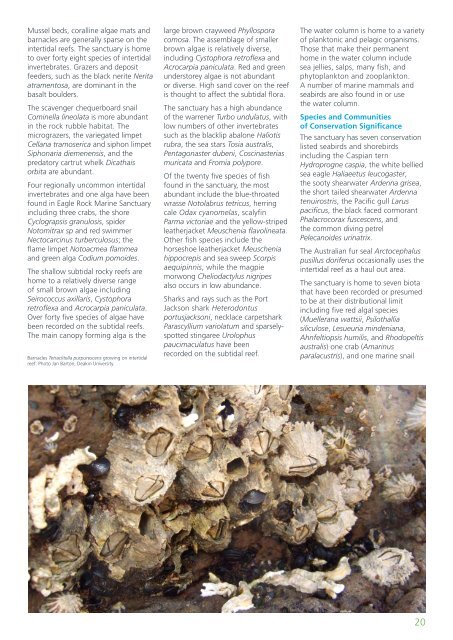Marine Natural Values Study Summary - Parks Victoria
Marine Natural Values Study Summary - Parks Victoria
Marine Natural Values Study Summary - Parks Victoria
Create successful ePaper yourself
Turn your PDF publications into a flip-book with our unique Google optimized e-Paper software.
Mussel beds, coralline algae mats andbarnacles are generally sparse on theintertidal reefs. The sanctuary is hometo over forty eight species of intertidalinvertebrates. Grazers and depositfeeders, such as the black nerite Neritaatramentosa, are dominant in thebasalt boulders.The scavenger chequerboard snailCominella lineolata is more abundantin the rock rubble habitat. Themicrograzers, the variegated limpetCellana tramoserica and siphon limpetSiphonaria diemenensis, and thepredatory cartrut whelk Dicathaisorbita are abundant.Four regionally uncommon intertidalinvertebrates and one alga have beenfound in Eagle Rock <strong>Marine</strong> Sanctuaryincluding three crabs, the shoreCyclograpsis granulosis, spiderNotomitrax sp and red swimmerNectocarcinus turberculosus; theflame limpet Notoacmea flammeaand green alga Codium pomoides.The shallow subtidal rocky reefs arehome to a relatively diverse rangeof small brown algae includingSeirococcus axillaris, Cystophoraretroflexa and Acrocarpia paniculata.Over forty five species of algae havebeen recorded on the subtidal reefs.The main canopy forming alga is theBarnacles Tetraclitella purpurescens growing on intertidalreef. Photo Jan Barton, Deakin University.large brown crayweed Phyllosporacomosa. The assemblage of smallerbrown algae is relatively diverse,including Cystophora retroflexa andAcrocarpia paniculata. Red and greenunderstorey algae is not abundantor diverse. High sand cover on the reefis thought to affect the subtidal flora.The sanctuary has a high abundanceof the warrener Turbo undulatus, withlow numbers of other invertebratessuch as the blacklip abalone Haliotisrubra, the sea stars Tosia australis,Pentagonaster dubeni, Coscinasteriasmuricata and Fromia polypore.Of the twenty five species of fishfound in the sanctuary, the mostabundant include the blue-throatedwrasse Notolabrus tetricus, herringcale Odax cyanomelas, scalyfinParma victoriae and the yellow-stripedleatherjacket Meuschenia flavolineata.Other fish species include thehorseshoe leatherjacket Meuscheniahippocrepis and sea sweep Scorpisaequipinnis, while the magpiemorwong Cheliodactylus nigripesalso occurs in low abundance.Sharks and rays such as the PortJackson shark Heterodontusportusjacksoni, necklace carpetsharkParascyllium variolatum and sparselyspottedstingaree Urolophuspaucimaculatus have beenrecorded on the subtidal reef.The water column is home to a varietyof planktonic and pelagic organisms.Those that make their permanenthome in the water column includesea jellies, salps, many fish, andphytoplankton and zooplankton.A number of marine mammals andseabirds are also found in or usethe water column.Species and Communitiesof Conservation SignificanceThe sanctuary has seven conservationlisted seabirds and shorebirdsincluding the Caspian ternHydroprogne caspia, the white belliedsea eagle Haliaeetus leucogaster,the sooty shearwater Ardenna grisea,the short tailed shearwater Ardennatenuirostris, the Pacific gull Laruspacificus, the black faced cormorantPhalacrocorax fuscescens, andthe common diving petrelPelecanoides urinatrix.The Australian fur seal Arctocephaluspusillus doriferus occasionally uses theintertidal reef as a haul out area.The sanctuary is home to seven biotathat have been recorded or presumedto be at their distributional limitincluding five red algal species(Muellerana wattsii, Psilothalliasiliculose, Lesueuria mindeniana,Ahnfeltiopsis humilis, and Rhodopeltisaustralis) one crab (Amarinusparalacustris), and one marine snail20
















